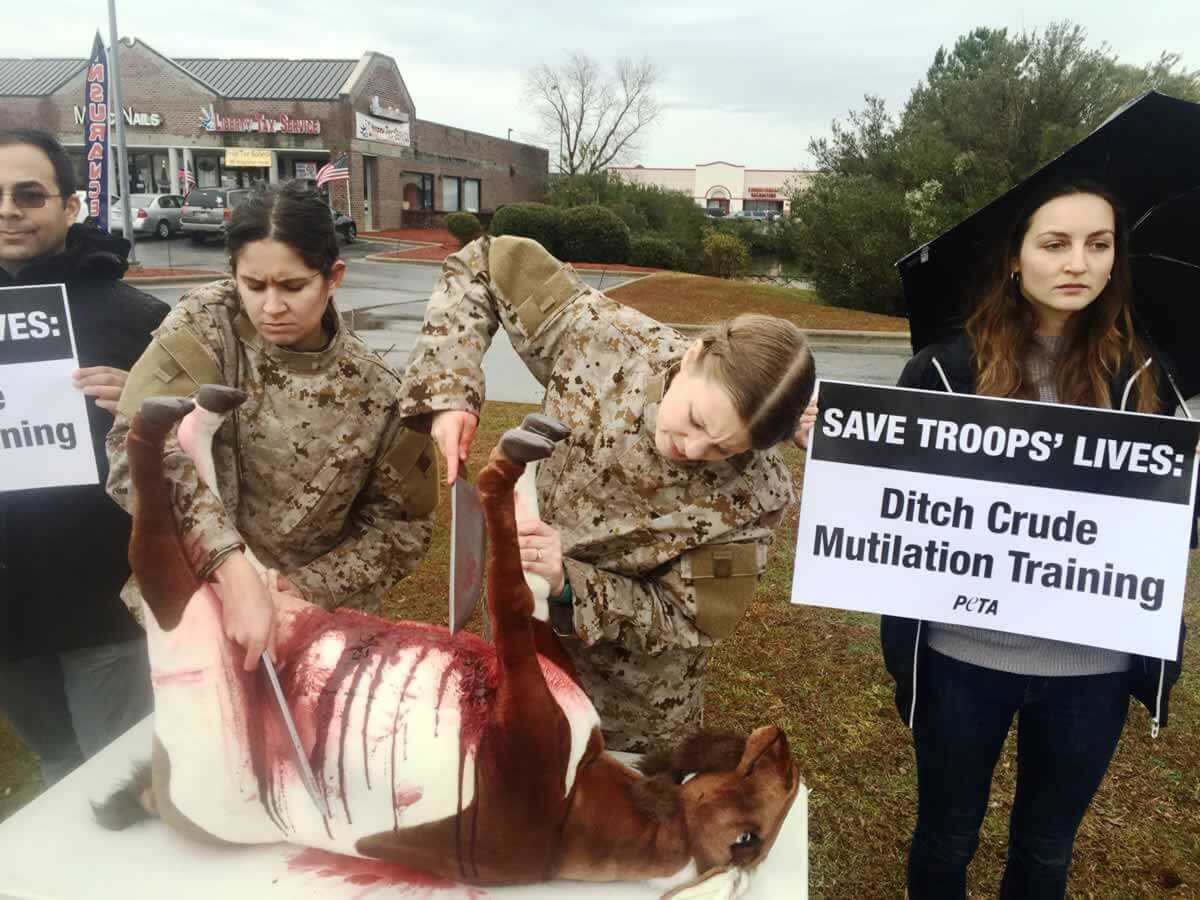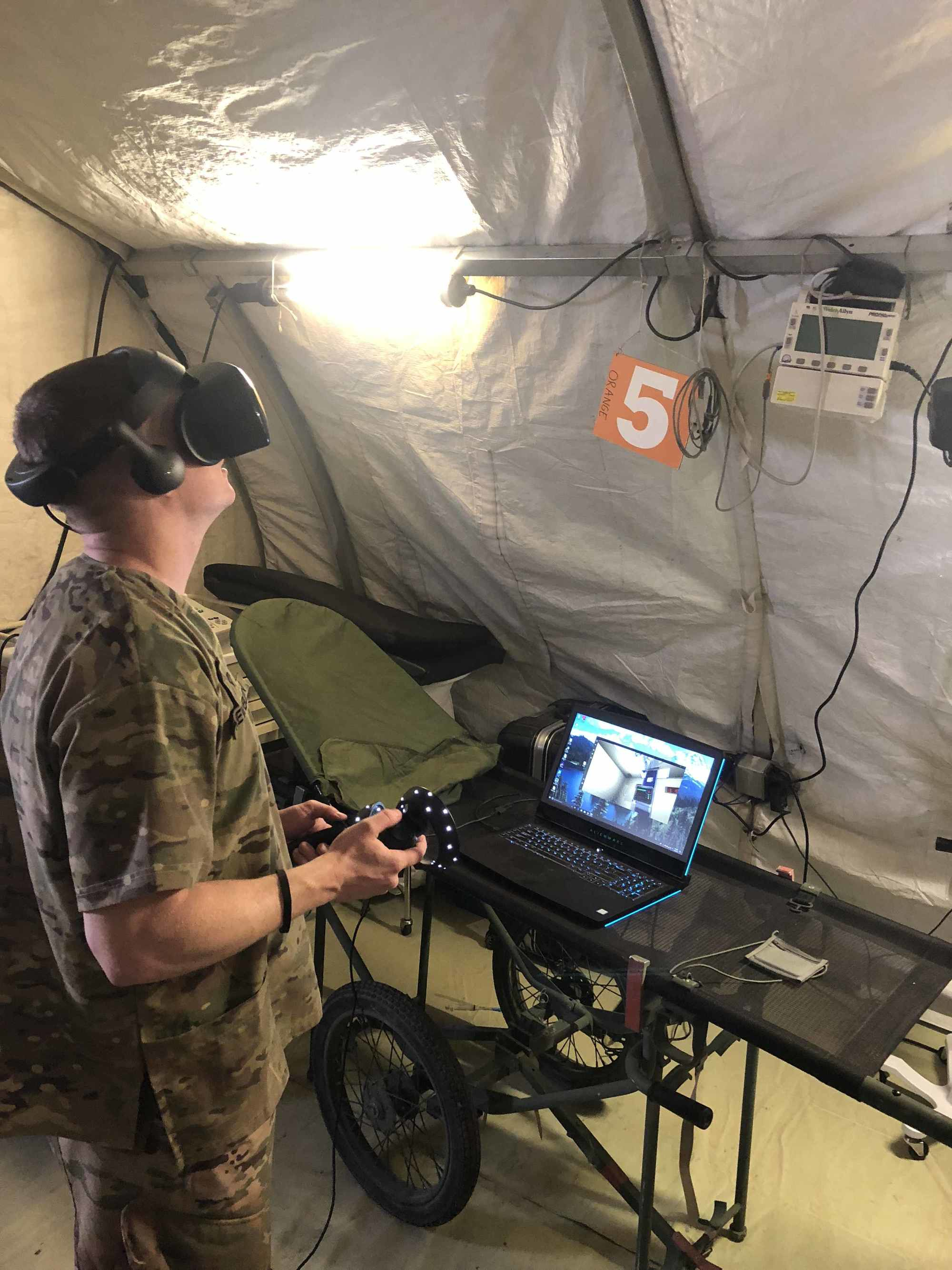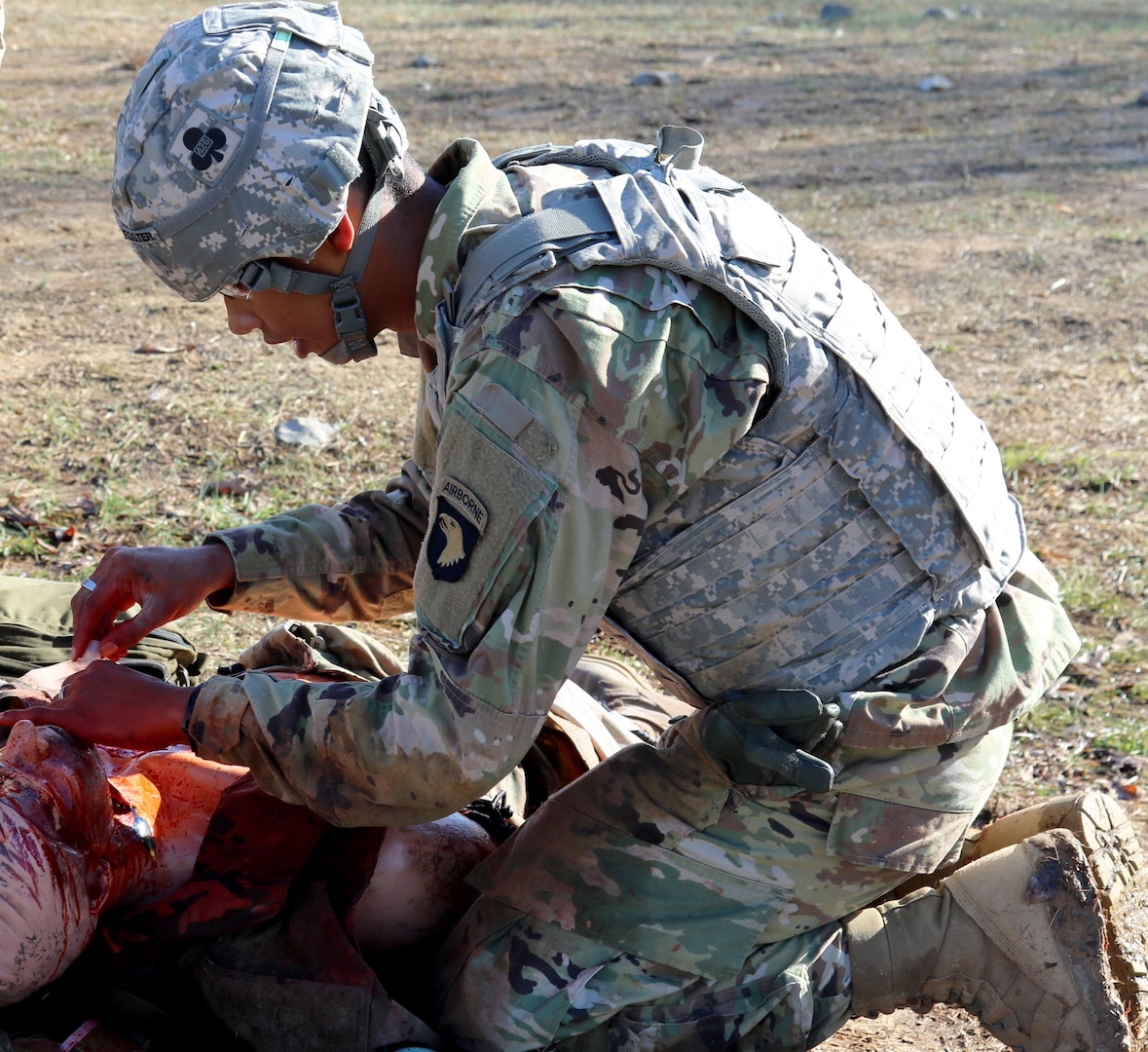Military Trauma Training - Reprint Address: Kenneth G. Proctor, Ph.D., Departments of Trauma and Surgical Critical Care, Department of DeWitt Daughtry Family Surgery, University of Miami Miller College of Medicine/Ryder Trauma Center, 1800 NW 10th Street, Miami, FL 33136; Email: [email protected].
The advantages of such training for military personnel are obvious. For example, a 2016 study in Military Medicine reported that military surgeons stationed at a civilian trauma center treated nearly six times more patients than surgeons at a nearby military station.
Military Trauma Training
 Source: assets.change.org
Source: assets.change.org
Furthermore, an Army orthopedic surgeon working at the Civilian Center conducted 242 cases that met the Air Force Combat Readiness Competency Checklist. The average at the military hospital is 12. "We're learning best practices from each other and using what we've learned in Iraq and Afghanistan, we're directly changing the care we provide on the South Side," he said.
The Demands Of Combat
“The care we provide on the South Side directly changes the care we can provide when our team is deployed.” The Pentagon recently invested nearly $10 million in MMR to investigate strategies to increase soldier survival rates by inducing a hibernation-like state.
It was first shown that hydrogen sulfide can cause "induced lethargy" in rats. An extension of this work would try to find scientific solutions that would allow human cells to survive with less oxygen in the bloodstream and keep soldiers alive for up to six hours despite massive blood loss.
Reducing the body's needs at the cellular level, regardless of the state of consciousness. If successful, this area of MMR could have applications in the civilian world, for example helping victims of motor vehicle accidents. Joint military and civilian training efforts date back to the 1990-1991 Gulf War and are still ongoing.
For example, the Air Force's C-STARS (Trauma Skills and Readiness Support Center) program rotates entire trauma teams over a two-week period at civilian trauma centers such as the University of Maryland Medical Center and St. Louis University Hospital.
A Shared History Of Service
University of Cincinnati Medical Center. Other fellowships provide extended courses for surgeons, nurses, physicians, and other staff. In the first few months of his life, Blackett performed 50% more surgeries than he would have done as an active surgeon in a military hospital and treated a wide variety of patients with a wide variety of injuries and ailments.
 Source: 1.bp.blogspot.com
Source: 1.bp.blogspot.com
He is also building new relationships through the medical campus and the University of Chicago, where he is already involved in several basic science research projects. The “common denominator” on both sides of this debate should primarily be increased safety and security of service personnel, along with improved human welfare and protection of animals used for LTTT, CWDR and MMR purposes.
It should be noted that US Animal Welfare Act Section 28 authorizes the use of live animals for research and training purposes in both the civilian and military sectors. However, the role of this law is to regulate the humane treatment of animals.
Prompt investigation of violations of the law. Routine behavioral monitoring often includes unannounced visits to research and training facilities with the goal of ensuring that animals are treated humanely and with the utmost care. Actions taken for non-compliance can be severe and range from formal warnings to institution fines, suspensions or revocations of research permits.
An Ideal Training Environment
Now retired from active military service and serving as a civilian professor at USUHS, Bauer works part-time at MedStar Washington. There, he and other specialists train 15 to 20 Army physicians annually. Military members typically spend a month on the MedStar surgical team, participating in the same academic curriculum as civilian interns, including lectures and seminars, explains Jack Sava, M.D., chief of trauma for MedStar Washington.
Most surgeons are trained to "finish what you start," Haight notes, but this can be a handicap during wartime. "You really have to prepare as a combat surgeon to do what we call damage reduction surgery," she says.
It's a real mental discipline to say, "I can do this, but the patient is better off if they end up in the next, safer, cleaner level of care." To help surgeons and other caregivers better prepare for dealing with such traumatic injuries, the U.S. Armed Forces and the military often send their medical personnel to trauma centers in teaching hospitals, where they are more likely to sustain serious gunshot, stabbing, and vehicle wreck injuries.
civilian counterparts with opportunities to hone and maintain their clinical skills. It also brings the Army's unparalleled medical expertise to partner trauma centers. A college vet in Hamilton cites some stark differences in the real world.
 Source: www.peta.org
Source: www.peta.org
He explained that (anti-censorship) groups are often used deliberately 23 For example, that under these circumstances, the pigs used in the ATTC were well taken care of. - Trained and dedicated staff who ensure they are housed in a comfortable environment, fed and treated with the utmost care and respect.
Before being delivered to the establishment, the pigs will be transported in an air-conditioned truck and given a period of time to acclimate to their new surroundings. Pigs will be carefully anesthetized prior to the ATTC procedure, and pigs will be humanely euthanized with an overdose of anesthesia while unconscious before training is completed.
The entire protocol certainly does not reflect the inhumane treatment of animals as some anti-vigilant groups claim. Garcia explains that the ability to communicate and make decisions quickly is key. “All surgeries are somewhat stressful and stressful,” he says, but because trauma has to make the right decision in a second — what are we going to do next?
You cannot schedule your surgery a week from now. The Army launched its AMCT3 program in 2019. Today it operates seven AMCT3 training sites in busy trauma centers across the country, including Vanderbilt University Medical Center, University of North Carolina Medical Center, Cooper University Hospital, and Oregon Health & Science University Hospital.
. Boyer spent 10 years as a professor at the University Uniformed Services of the Health Sciences (USUHS) in Bethesda, "ensuring that the next generation of young physicians can care for those in harm's way." Thorson, Chad M. MD, MSPH;
DuBose, Joseph J. REE, Peter MD; Knuth, Thomas E. Durlac, Warren C. Bailey, Jeffrey A. MD; Garcia, George D. MD; Ryan, Mark L. Van Haren, Robert M. MD; Proctor, Kenneth G. Ph.D. Veterans with extensive experience dealing with injuries common to modern military conflicts are also strong advocates of LTTT and MMR for lifesaving purposes, seeing the benefits of LTTT, circulatory training, and CWDR.
Life on animals (souls of soldiers sent to war). They are of the opinion that the LTTE should not be seen as "ignoring animals". It is the thoughtful concern and concern for the survival of the men and women sent to war that to provide them (the doctors) with all the tools and training which will assist them in saving lives.

In terms of military medical readiness for treating combatants, advocates strongly believe that LTTT is the current solution because it is effective (it saves lives) and is the most advanced type of training available. It trains its participants to observe, evaluate, triage, and process depending on the severity of the penetrating trauma presented, and is placed in a "battlefield scenario" that requires quick decision-making in an "extreme stress" environment.
The course is always challenging for participants 7. LTTT participants develop an individual level of experience and confidence in their ability to treat actual combat injuries. Army Surgeon in the US Army Reserves and a freshman veteran.
- Yosago Medicine was the driving force behind the partnership. After multiple deployments to Iraq and Afghanistan, as well as his previous work at major US trauma centers, Wilson understands the importance of this type of trauma training.
“In the military, whether it's Walter Reed or Fort Campbell or whatever hospital they're stationed at, they don't get trauma,” says Jorge Garcia, MD, a retired Army surgeon and now a trauma surgeon at the Ryder Trauma Center.
University of Miami. The center "offers the opportunity to get back into the groove of caring for critically injured patients," García explains. Twenty-man surgical teams from across the country train at Ryder for two weeks before they deploy.
These typically include surgeons, nurse anesthetists, operating room technicians, ICU technicians, recovery room nurses, and physicians. An important goal is to allow the entire team to train together in a clinical setting, which Garcia says is not usually possible in state military hospitals.
Garcia highlights some of the benefits of training: "I think it's important for them to do [work] in a 'safe' environment, where someone is watching them and reminding them of things before they actually go out. There's no backup," he notes.
 Source: assets.cureus.com
Source: assets.cureus.com
Preparing surgeons for the demands of combat is no easy feat, Bauer says. "One of the things we need to do is break the notion that just because you're a surgeon you can go into trauma," he notes.
In the state, operations are carried out relatively quietly, usually not "with the patient trying to die, with bleeding from several places." from Dewitt-Daughtry Family Surgery (C.M.T., M.L.R., R.M.V.H., K.G.P.), and Military Trauma Training Center (T.E.K., GDG), Ryder Trauma Center, Miller School of Medicine, University of Miami, Miami;
Air Force Trauma Sustainability and Preparedness Skills (JJD) Center, University of Maryland Trauma Center, Baltimore, MD; Naval Trauma Training Center (P.R.), Los Angeles, CA; Cincinnati Preparedness and Injury Skills Preservation Centers (WCD), Cincinnati, OH; St. Louis Trauma and Preparedness Skills Support Center (JAB), St. Louis University, St. Louis, MO.
P.R. Now with the Division of Traumatology, Critical Care, and Emergency Surgery, Arizona Health Sciences Center, Tucson, AZ. WCD is now with the University of Cincinnati in Cincinnati, Ohio. c. Now with Integrated Trauma System, US Army Institute of Surgical Research, Fort Sam Houston, TX.
T. In private practice in Grosse Pointe Farms, Michigan. “My associates who have no military experience obtain—I hope—the satisfaction of preparing these men and girls to go abroad and do some really important work. Their patients, in my opinion, are the nation's most valuable asset.”
In combat situations, military surgeons treat gunshot wounds, amputations, and mutilated cadavers. "Think of the most critically wounded patient you've ever cared for," says Mark Bauer, MD, a retired Air Force surgeon formerly known as the "Trauma Caesar" in Iraq.
"We might get three, four or more of them a day — day in and day out." Find similar articles You can search for similar articles containing these keywords, or you can modify the keyword list to narrow your search.

There are a number of general training simulators that have improved their ability to provide useful training, but they still lack the full ability to integrate all aspects of live tissue training. 44 For this reason, the American College of Surgeons (ACS) supports "human care, treatment, use of laboratory animals used in research, education, teaching and product safety test in accordance with the well -being of the local, state and federal animal.
සඳහා විකල්ප සංවර්ධනය කර සේවයේ යුතු යුතු නමුත් නමුත් දැන් අපේක්ෂා කළ හැකි සතුන්ගේ භාවිතය සම්පූර්ණයෙන්ම ප්රතිස්ථාපනය කළ නොහැකි සමස්ත ජීවී අධ්යයනය බවත් විශ්වාස කරයි කරයි. ජීවීන්, පටක සහ සෛල ජෛවවෛද්ය පර්යේෂණ, අධ්යාපනය සහ ඉගැන්වීමේයවශ්ය අංගයකි අංගයකි ”45 සතුන් ගනිමින් ගනිමින් surored flight trading පවත්වන මිචිගන් විශ්වවිද්යාලයට (um) එරෙහිව Peta 2010 දී USDA වෙත පැමිණිල්ලක් කළේය කළේය කළේය කළේය කළේය එහි එහි එහි එහි එහි එහි එහි එහි එහි එහි එහි එහි එහි එහි එහි එහි එහි එහි එහි එහි එහි එහි එහි එහි එහි එහි එහි එහි එහි එහි එහි එහි එහි එහි එහි එහි එහි එහි එහි එහි එහි එහි එහි.
සඳහා හදිසි ගුවන්ප්රවාහන සේවය පිරිස් පිරිස් පිරිස් පිරිස් පිරිස් පිරිස් පිරිස් පිරිස් පිරිස් පිරිස් පිරිස් පිරිස් පිරිස් පිරිස් පිරිස් පිරිස් පිරිස් පිරිස් පිරිස් පිරිස් පිරිස් පිරිස් පිරිස් පිරිස් පිරිස් පිරිස් පිරිස් ඇතුළත් ඇතුළත් ඇතුළත් ඇතුළත් ඇතුළත් වන වන වන වන වන වන වන වන වන වන ඇතුළත් ඇතුළත් භාවිතා භාවිතා භාවිතා කළ කළ යුතු බවයි බවයි බොහෝ ආයතනවල වෛද්
සහ පර්යේෂකයන් විකල්පප්රවේශයන් භාවිතා කිරීම ප්රයෝජනය ඉතා වැදගත් බව පිළිගනිති ඔවුන් අනවශ්ය ලෙස නොසැලකිලිමත් ලෙස සතුන් භාවිතා නොකරයි නොකරයි සියලුම පුද්ගලයින් පර්යේෂණ හෝ පුහුණුව සඳහා භාවිතා කිරීම වරප්රසාදයක් ලෙස අතර අතර ඔවුන්ට උපරිම සැලකිල්ලෙන් හා ගෞරවයෙන් මෙය ප්රදර්ශනය කරයි කරයි යුධ වෛද්වෛද්ය
නිලධාරීන් Uchicago Medicine හි කාවැද්දූ හෝ කාලීන භ්රමණ පැවරුම් පුහුණු කරනු ඇත ඇත . කාවැද්දූ අය චිකාගෝ හි ජීවත් අතර වසර තුනක් දක්වා පූර්ණ කාලීන කාර්ය ලෙස සේවය ඇත ඇත ඇත. අවසානයේදී, ශල්ය වෛද්යවරුන්, හදිසිවෛද්ය වෛද්යවරුන්, හදිසි සහ සත්කාර හෙදියන් හෙදියන් නිර්වින්දන වෛද්යවරුන් සහ සහතික ලත් හෙද නිර්වින්දන වෛද්යවරුන්, සටන්යවරුන්, ශල්යාගාර කාර්මිකයන්, බලපත්රලාභී ප් හෙදියන් වෙනත් වෙනත්ශල්ය උප ඇතුළුව ඇතුළුව සෑම හමුදා වෛද්වෛද්ය නිලධාරීන් නිලධාරීන් ක් පමණ හි පුහුණු පුහුණු පුහුණු පුහුණු පුහුණු හි හි
කරනු ඇත. ඔහුප්රාන්තයට ආපසු පැමිණි විට ගාර්ෂියා රයිඩර් කම්පන මධ්යස්ථානයේ හමුදායයයවරුන්ට ඉගැන්වීමට පටන් ගත්තේය ගත්තේය. සෑම වසරකම රයිඩර් හරහා පැමිණෙන රෝගීන් 3,500 න් දළ වශයෙන් 25% කට වෙඩි සහ පිහියෙන් තුවාල වැනි විනිවිද පෙනෙන තුවාල ඇති බව පවසයි පවසයි පවසයි පවසයි පවසයි පවසයි පවසයි පවසයි පවසයි පවසයි පවසයි පවසයි පවසයි පවසයි පවසයි පවසයි පවසයි
නමුත් ඔහුගේ පළකිරීමෙන් ඔහු සේවය කරන විට බෝයර් අත්විඳින ආකාරයේ කාර්යයක් ලබා නැත නැත. මට මගේ දක්ෂතා ඉහළ මට්ටමක තබා සහ හමුදාවට බොහෝ ප්රයෝජන ගැනීමට නම් නම් මට පිළිබඳ ක්රියාකාරී පුහුණුවක්ය විය විය විය බෝයර් බෝයර් පවසයි.
එබැවින් ඔහු MEDSTAR Washington Hospital Center හි ජාතියේ පුහුණුව ලබමින් සිටි හමුදා ශල්ය වෛද්යවරුන් අනුගමනය කළේය කළේය කළේය කළේය කළේය කළේය කළේය කළේය කළේය කළේය කළේය කළේය සාම කාලයේ හමුදා පසුබිම මට කළ නොහැකි කම්පන සැත්කම් කිරීමට එය මට ලබා දුන්නේය දුන්නේය. ”
අද, 127 va පහසුකම්, වෛද්ය පුහුණුව සඳහා ජනපද වෛද්ය විද්යාල 130 කට සංඛ්යාවක් සමඟ අනුබද්ධ ඇත ඇත ඇත ඇත ඇත ඇත. VA හවුල් අධ්යාපනය, සෞඛ්ය සේවා සහ ව්යාපෘති ඇතුළුව නොයෙකුත් සඳහා වෛද්ය විද්යාල සහ ශික්ෂණ රෝහල් සමඟ වේ වේ වේ.
බොහෝ වෛද්ය විද්යාල පීඨ සාමාජිකයින් ද va මධ්යස්ථානවල ඉගැන්වීම සහ ලබා දෙන අතර එක්සත් වෛද්යවරුන්ගෙන් 70% කට වඩා වැඩි පිරිසක් va සෞඛ්ය සේවා පද්ධතිය පිළිබඳ ලබා ඇත ඇත ඇත. කැලිෆෝනියා විශ්ව විද්යාලය (යූසී) ඩේවිස් සමඟ හමුදා කම්පන අධ්යාපන වැඩසටහනක් කිරීමට උදව් කළ හයිට් පවසන්නේ ”[අධ්යාපනයේ] කොටසක් තුවාලකරුවන් රැකබලා රැකබලා සහ ප්රමුඛතා තිබිය යුතු ස්ථානය පිළිබඳ ලබා ගැනීමට වී සිටීමයි සිටීමයි සිටීමයි සිටීමයි සිටීමයි සිටීමයි සිටීමයි සිටීමයි සිටීමයි සිටීමයි සිටීමයි සිටීමයි සිටීමයි සිටීමයි සිටීමයි සිටීමයි සිටීමයි සිටීමයි සිටීමයි සිටීමයි
2009 දී වෛද්ය මධ්යස්ථානය. සිවිල් කම්පන පුහුණුව සඳහා හමුදාශල්ය වෛද්යවරුන් ඒකාබද්ධ කිරීමට අමතරව අමතරව මෙම මඟින් ඔවුන්ගේ වසර හෝ හතරක හතරක USAF රාජකාරි පැවරුම් පුරා කාල කාල පරිච්ඡේද සිවිල් කම්පන සත්කාර සඳහා සහායක පුද්ගලයින්රමණය කරයි.
army trauma training center, gti trauma training, military trauma courses, military trauma surgeon training, army trauma training course, trauma medicine training, trauma medical training near me, trauma medical training
0 Comments